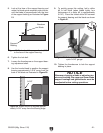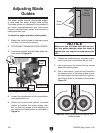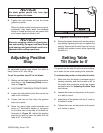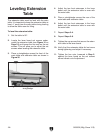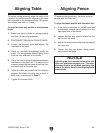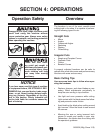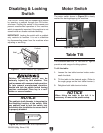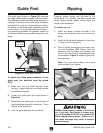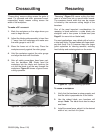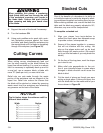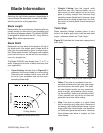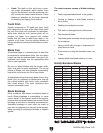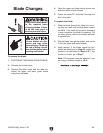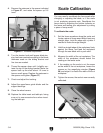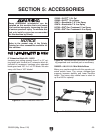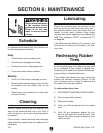
G0555X (Mfg. Since 1/12)
-29-
"Crosscutting" means cutting across the grain of
wood. For plywood and other processed wood,
crosscutting simply means cutting across the
width of the workpiece.
To make a 90˚ crosscut:
1. Mark the workpiece on the edge where you
want to begin the cut.
2. Adjust the blade guide assembly to less than
1" away from the workpiece and make sure
the miter gauge is set to 90°.
3. Move the fence out of the way. Place the
workpiece evenly against the miter gauge.
4. Hold the workpiece against the miter gauge
and align the mark with the blade.
5. After all safety precautions have been met,
turn the bandsaw ON. Slowly feed the
workpiece into the blade and continue the
cut until the blade is all the way through the
workpiece. Figure 32 shows a typical cross-
cutting operation.
Figure 32. Typical crosscutting operation.
Crosscutting
Figure 33. Typical resawing operation.
"Resawing" (Figure 33) means cutting the thick-
ness of a board into two or more thinner boards.
The maximum board width that can be resawn
is limited by the maximum cutting height of the
bandsaw.
One of the most important considerations for
resawing is blade selection—a wide blade cuts
straighter and is less prone to blade lead (see
Page 41 for more info on blade lead).
For most applications, use a blade with a hook or
a skip tooth style. Choose blades with fewer teeth-
per-inch (from 3 to 6), because they offer larger
gullet capacities for clearing sawdust, reducing
heat buildup and reducing strain on the motor.
To resaw a workpiece:
1. Verify that the bandsaw is setup properly and
that the table is perpendicular to the blade.
2. Use the widest blade your bandsaw will
accept. Note: The blade must also be sharp
and clean.
3. Install the resaw fence, adjust it to the desired
width of cut, and lock it in place.
Resawing



